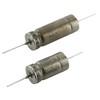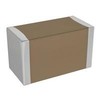Help with Tantalum Capacitors specifications:
General Specifications
Back to Top
|
|
| ||
| Configuration / Form Factor | |||
| Your choices are... | |||
| Leaded Capacitor | Capacitors have leads for connections to circuits. | ||
| Surface Mount / Chip Capacitor | Chip capacitors or surface mount capacitors do not have leads. | ||
| Other | Other unlisted configurations or form factors. | ||
| Search Logic: | All products with ANY of the selected attributes will be returned as matches. Leaving all boxes unchecked will not limit the search criteria for this question; products with all attribute options will be returned as matches. | ||
| Technology | |||
| Your choices are... | |||
| Multilayer | The dielectric is made of many layers. Multilayer devices are small in size. They provide excellent temperature stability and frequency characteristics. | ||
| Monolithic / Single Layer | The dielectric is made of a single layer. | ||
| Wound | Wound capacitors are built by winding foils, sometimes by hand. | ||
| Other | Other unlisted, specialized, or proprietary types or technologies. | ||
| Search Logic: | All products with ANY of the selected attributes will be returned as matches. Leaving all boxes unchecked will not limit the search criteria for this question; products with all attribute options will be returned as matches. | ||
| Capacitance Type | |||
| Your choices are... | |||
| Fixed | Capacitors have a fixed, nonadjustable capacitance value. | ||
| Variable | With variable capacitors, specific capacitance values can be set via an adjustment mechanism, typically a potentiometer. | ||
| Search Logic: | All products with ANY of the selected attributes will be returned as matches. Leaving all boxes unchecked will not limit the search criteria for this question; products with all attribute options will be returned as matches. | ||
| General Features | |||
| Your choices are... | |||
| Polarized? | Polar or polarized capacitors may be operated safely with only one direct current (DC) polarity. By contrast, nonpolar capacitors can be operated without regard to polarity. Sometimes, polar caps are combined in special ways to allow a limited ability to cope with reversing polarity. These devices are called bipolar capacitors. | ||
| No Piezoelectric Effects | Capacitors do not exhibit capacitance variation with voltage or pressure. | ||
| Self-healing | Capacitors can withstand high-pulsed voltages without breaking the dielectric. This feature is particularly important in high-voltage applications. | ||
| Military Standards | Capacitors meet military standards. | ||
| Search Logic: | All products with ANY of the selected attributes will be returned as matches. Leaving all boxes unchecked will not limit the search criteria for this question; products with all attribute options will be returned as matches. | ||
RoHS Compliance
Back to Top
|
|
| ||
| RoHS Compliant | Restriction of Hazardous Substances (RoHS) is a European Union (EU) directive that requires all manufacturers of electronic and electrical equipment sold in Europe to demonstrate that their products contain only minimal levels of the following hazardous substances: lead, mercury, cadmium, hexavalent chromium, polybrominated biphenyl and polybrominated diphenyl ether. RoHS will become effective on July 1, 2006. | ||
| Search Logic: | "Required" and "Must Not Have" criteria limit returned matches as specified. Products with optional attributes will be returned for either choice. | ||
Performance
Back to Top
|
|
| ||
| Capacitance Range | The capacitance range of the capacitor. Fixed capacitors have only one value. Variable capacitors have a range of capacitance values. Capacitance measures the ability to store energy, given as C = K A/D, where A is the area of the electrodes, D is their separation, and K is a function of the dielectric between the electrodes. The formula yields a result in farads (F), but a farad is so large that the most commonly used values are expressed in microfarads (µf = 10-6F) or picofarads (pf = 10-12F). | ||
| Search Logic: | User may specify either, both, or neither of the "At Least" and "No More Than" values. Products returned as matches will meet all specified criteria. | ||
| Capacitance Tolerance | The precision of the capacitance produced by the capacitor, measured as a percent of the capacitance. | ||
| Search Logic: | All matching products will have a value less than or equal to the specified value. | ||
| DC Rated Voltage Range (WVDC) | DC rated voltage range (WVDC) is the maximum continuous DC voltage that may be continuously applied to a capacitor at any temperature between the lower category temperature and the rated temperature. It is also known as working DC voltage (WVDC). | ||
| Search Logic: | User may specify either, both, or neither of the "At Least" and "No More Than" values. Products returned as matches will meet all specified criteria. | ||
| ESR | Equivalent series resistance (ESR) represents the extent to which the capacitor acts like a resistor when charging and discharging. This functions via a resistive element within the capacitor model, found in both the AC and DC domains. Contributing factors include electrodes, leads, and the dielectric. ESR can change with variables such as frequency, time, etc. It is a measure of the capacitor's total loss range, which includes the leads, electrodes, dielectric losses, leakage (IR) and, most importantly, the end spray connecting the leads to the metallized film. The lower the ESR, the higher the current carrying ability of the capacitor. | ||
| Search Logic: | All matching products will have a value less than or equal to the specified value. | ||
| Leakage Current | Leakage current is the current flowing from one conductor to an adjacent conductor through an insulating layer. The leakage current in a capacitor is measured after 3 minutes at 25 °C, through a 1kΩ resistor connected in series with the capacitor, and with rated voltage applied. | ||
| Search Logic: | User may specify either, both, or neither of the "At Least" and "No More Than" values. Products returned as matches will meet all specified criteria. | ||
| Dissipation Factor | The dissipation factor (DF) is the ratio between the resistive and the reactive part of the impedance of the capacitor submitted to a sinusoidal voltage of specified frequency. It is a measure of the losses in the capacitor. DF is normally expressed as a percentage or a decimal equivalent. | ||
| Search Logic: | All matching products will have a value less than or equal to the specified value. | ||
| Operating Temperature | This is the full-required range of ambient operating temperature. | ||
| Search Logic: | User may specify either, both, or neither of the limits in a "From - To" range; when both are specified, matching products will cover entire range. Products returned as matches will meet all specified criteria. | ||
Packaging Specifications
Back to Top
|
|
| ||
| Lead / Termination Type: | |||
| Your choices are... | |||
| Surface Mount Technology (SMT) | Devices that use surface mount technology (SMT) do not have leads. Instead, they are pad-mounted. | ||
| Axial Leads | Axial leads extend from the ends and along the axis of the resistor, capacitor, or other axial part. They do not extend from the sides. | ||
| Radial Leads | Radial leads extend from the sides instead of from the ends. | ||
| Flying Leads | Flying leads project horizontally. | ||
| Tab Leads | Tab leads are terminals that are designed for direct mounting into a circuit board socket. | ||
| Screw Leads | Capacitor leads are designed to be fastened with screws. | ||
| Gull Wing Leads | Gull wing leads are used widely because they are relatively inexpensive to mold and form. Gull wings are flexible and can withstand thermal expansion and contraction. It is easy to inspect the integrity of gull wings leads to circuit board solder connections. | ||
| J-Leads | J-leads are popular because they use less PCB real estate than gull wing leads; however, the J-lead to board solder connections are hidden from inspection and the leads are more difficult to form. | ||
| Other | Other unlisted lead types. | ||
| Search Logic: | All products with ANY of the selected attributes will be returned as matches. Leaving all boxes unchecked will not limit the search criteria for this question; products with all attribute options will be returned as matches. | ||
| Mounting Style | |||
| Your choices are... | |||
| Through Hole Technology (THT) | Through hole technology (THT) mounts components on a printed circuit board (PCB) by inserting component leads through holes in the board and then soldering the leads in place on the opposite side of the board. | ||
| Surface Mount Technology (SMT) | Surface mount technology (SMT) adds components to a printed circuit board (PCB) by soldering component leads or terminals to the top surface of the board. SMT components have a flat surface that is soldered to a flat pad on the face of the PCB. Typically, the PCB pad is coated with a paste-like formulation of solder and flux. With careful placement, SMT components on solder paste remain in position until elevated temperatures, usually from an infrared oven, melt the paste and solder the component leads to the PCB pads. Industry-standard pick-and-place equipment can mount SMT components quickly, accurately, and cost-effectively. SMT is a widely used alternative to mounting processes that insert pins or terminals through holes and solder leads into place on the opposite side of the board. | ||
| Bolt Mounted | The capacitor is mounted by bolting in place. A bolt is a threaded fastener, with a head. Normally a nut is used to secure the bolt. | ||
| Bracket Mount | Capacitor either requires or comes with bracket for mounting. A bracket is a support or fixture to hold something up. In a bracket mounted capacitor, the bracket can be bolted. | ||
| Pole Mount | Devices mount on poles and require special pole-mounting brackets. | ||
| Other | Other unlisted mounting types. | ||
| Search Logic: | All products with ANY of the selected attributes will be returned as matches. Leaving all boxes unchecked will not limit the search criteria for this question; products with all attribute options will be returned as matches. | ||
| Packing Method | |||
| Your choices are... | |||
| Tape Reel | Components are packed in tape reel assemblies that include a carrier tape with embossed cavities for storing individual components. A cover tape seals the carrier tape in place. This composite tape is then wound on a reel that is placed in a corrugated shipping box for transport and delivery. Customers unpack the reels and load them into industry-standard, pick-and-place board assembly equipment. Tape and reel assemblies provide component isolation and are designed for surface mount packages such as quad flat package (QFP) and thin quad flat package (TQFP). Typically, carrier tape is made from a polystyrene (PS) or PS-laminate film with a uniform film thickness between 0.2 mm to 0.4 mm. Carrier tape design is defined largely by component length, width, and thickness. Cover tape is made from a polyethylene teraphthalate (PET) film or film laminate with an adhesive applied to the underside of the film. This adhesive is usually heat and pressure sensitive to ensure a positive, consistent seal between the carrier tape and the cover tape. The reels that contain the composite tape are typically made of polystyrene and have one, two, or three parts. Reel dimensions meet EIA-481-1, EIA-481-2, and EIA-481-3 standards. | ||
| Tray / Rail | Components are packed in trays (rails) that are made of carbon-powder or fiber materials and molded into rectangular outlines that contain matrices of uniformly spaced pockets. These containers protect components during shipping and provide proper component location and orientation for use with industry-standard, pick-and-place board assembly equipment. Trays are designed for components for that have leads on four sides and that require component lead isolation during shipping, handling, or processing. For example, quad flat package (QFP) and thin quad flat package (TQFP) components are often shipped in trays. To facilitate shipping and handling, trays are stacked and bound together in standard configurations. To provide rigidity, an empty cover tray is added to the top of the load. Typical stacking configurations consist of five full trays and one cover tray, and ten full trays and one cover tray. Customer requirements determine whether trays are shipped in single or multiple stacks. | ||
| Shipping Tube / Stick Magazine | Components are packed in shipping tubes or stick magazines that are made of rigid polyvinylchloride (PVC) and extruded in industry-standard sizes. These containers protect components during shipping and provide proper component location and orientation for use with industry-standard, pick-and-place board assembly equipment. To facilitate shipping and handling, shipping tubes and stick magazines are usually loaded into intermediate containers such as boxes or bags to form standard quantities. Intermediate-level packing quantities for shipping tubes and stick magazines often vary by pin count and package type. | ||
| Bulk Pack | Components are distributed as individual parts. | ||
| Other | Other unlisted, specialized or proprietary packing methods. | ||
| Search Logic: | All products with ANY of the selected attributes will be returned as matches. Leaving all boxes unchecked will not limit the search criteria for this question; products with all attribute options will be returned as matches. | ||


